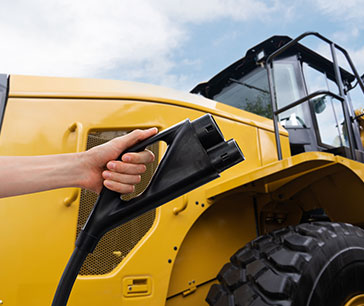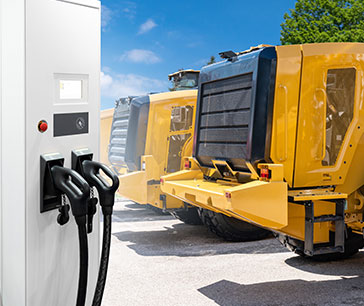Table Of Contents
- The Current State of Electric Construction Equipment
- Innovative Technologies in Electric Construction Equipment
- Economic Opportunities in Electric Construction Equipment
- Challenges and Barriers to Electric Construction Equipment
- Strategic Moves by Key Players
- Product Launches
- Partnership and Collaboration
- The Future of Electric Construction Equipment

Sonia Mutreja

Akshay Jadhav
Shaping the Future: Unveiling the Spark in Electric Construction Equipment Trends

The construction industry is rapidly moving towards electric solutions owing to the growing recognition of the need for environmental responsibility, sustainability, and improved operational effectiveness in the construction industry. Electric construction equipment runs on electricity instead of internal combustion engines. The most common electric construction equipment includes excavators, loaders, bulldozers, cranes, concrete mixers, pavers drills, and breakers. This electric construction equipment is powered with often lithium-ion battery packs. They offer lower reduced noise levels, emissions, and potentially lower operating costs compared to fuel-powered construction equipment. Developments in battery technology and the ongoing development of efficient electric gear boost their competitiveness, pushing construction firms to use such innovative solutions. This shift is further boosted by the quieter functioning of electric equipment and the rising demand for ecologically friendly activities.
The Current State of Electric Construction Equipment
The increase in focus on the adoption of electric equipment in the construction sector is driven by the growing prominence of advancements in battery technology, sustainability, and environmental concerns. The primary reason for tilting towards electric construction equipment is the desire to reduce the environmental impact of construction activities. Generally, construction equipment powered by IC engines causes greenhouse gas emissions, air pollution, and noise pollution. Electric equipment offers zero-emission alternatives helping to ease the industry's environmental footprint. Fuel engines used in traditional equipment release carbon monoxide, nitrogen oxides, and others, which can have adverse effects on air quality and human health.

Electric construction equipment does not include tailpipe emissions, which contributes to improved local air quality in urban and densely populated areas. The construction industry is a substantial contributor to carbon emissions. Electric construction equipment, powered by batteries from renewable and cleaner sources, plays a role in mitigating climate change. This shift helps global efforts to reduce carbon emissions and transition to more sustainable practices. Many companies are focusing on developing electric construction equipment with fast charging technology. For instance, in October 2022, Japan-based Komatsu Ltd. and U.S.-based Proterra collaborated to develop medium-sized electric excavators with high energy density and fast charging technology.
Innovative Technologies in Electric Construction Equipment
The adoption of electric construction equipment is important for meeting regulatory requirements, addressing environmental challenges, and aligning with broader sustainability goals. As technology continues to advance and the construction equipment industry evolves, the transition to electric equipment is expected to play a crucial role in creating a more sustainable and eco-friendly construction sector.
The leading construction equipment manufacturers such as Caterpillar Inc., Volvo Construction Equipment, Komatsu Ltd., Hitachi Construction Machinery, JCB, Liebherr Group, Deere & Company, Kobelco Construction Machinery, Doosan Infracore, and others have been investing in the development of electric construction equipment. For example, in September 2023, Honda Motor Co., Ltd., and Komatsu Ltd. developed a PC05E-1 electric mini excavator in Japan. PC01E-1 and PC05E-1 are powered by the Honda eGX electrified power unit and are utilized for small-scale civil engineering and building projects, such as gas, electrical, and pipe-laying. Similarly, in November 2022, Caterpillar, a manufacturer of heavy-duty construction products, constructed and presented the world's first all-electric 793 mining truck with its massive 2,650 horsepower, to assist the mining sector in transitioning to more sustainable operations. In October 2022, Caterpillar offered four battery electric machines to its construction industry portfolio, including the 301.9 tiny excavator, 320 medium excavator, 950 GC medium wheel loader, and 906 compact wheel loader, which are among the battery electric machine prototypes. Caterpillar battery prototypes power the tractors, which also contain an onboard AC charger. The start-up further intends to offer offboard DC rapid charging.
Economic Opportunities in Electric Construction Equipment
Regulatory and government bodies are stressing implementing stricter environmental regulations and emission standards. The utilization of electric construction equipment permits manufacturers to implement these regulations, avoiding fines and penalties associated with non-compliance. Many companies are adopting environmentally friendly practices and sustainability targets into their operations. The adoption of electric construction equipment aligns with these corporate sustainability goals, demonstrating a commitment to responsible business practices. For instance, in June 2022, Komatsu Ltd., a global producer of construction and mining equipment and services, and Cummins Inc., a global leader in power technology, signed a memorandum of understanding to work on the development of zero-emissions haulage equipment. Similarly, in October 2022, Moog, Inc. and Komatsu collaborated to create an all-new electric small wheel loader equipment. It exhibits features such as an electric traction motor, electric cylinders for lift, tilt, and steering, power electronics, a system control computer, a battery, and a battery management system.

Rising environmental concerns and growing demand for greener alternatives act as the key driving forces of the electric construction and agriculture equipment market in Asia-Pacific. In addition, government backing, market potential fueled by economic expansion, and focus on technical innovation contribute toward market growth. The region's growing need for sustainable solutions in the building and agricultural sectors is further expected to open new avenues for the expansion of the market during the forecast period. Moreover, infrastructural development activities and collaborative efforts between technology providers and manufacturers accelerate chances for electric equipment uptake and development. China's construction equipment industry has grown rapidly. U.S. and Europe have led the globe in sales in recent years, accounting for almost half of the worldwide market.
The initial investment in electric construction equipment may be higher, businesses can realize long-term cost savings through reduced fuel and maintenance expenses. Additionally, lower operational costs can offset the initial purchase price over the equipment's lifespan.
Challenges and Barriers to Electric Construction Equipment
There is growing interest in adopting electric construction equipment, but several challenges and barriers currently hinder widespread adoption. These challenges include technological, economic, infrastructure, and regulatory factors.
High Initial Cost: Electric construction equipment has a higher upfront cost compared to IC engine counterparts. The initial investment includes the cost of advanced batteries, electric motors, and associated technologies. This can be a significant barrier for construction companies, particularly smaller ones with limited budgets.
Limited Range and Battery Life: The range and battery life of electric construction equipment can be a concern, especially for projects that require extended periods of operation. The need for frequent recharging or the limited range between charges may impact the efficiency and productivity of electric equipment on certain job sites.
Weight and Size of Batteries: The size and weight of batteries needed to power heavy construction equipment can be significant. This adds to the overall weight of the equipment, potentially impacting its performance and maneuverability. Advances in battery technology addressing energy density and weight are essential for overcoming this challenge.
Lack of Standardization: The absence of standardized interfaces and charging systems for electric construction equipment can be an obstacle. Standardization would promote interoperability, allowing different equipment models to use the same charging infrastructure and components.
Regulatory Challenges: Existing regulations and standards may not adequately address electric construction equipment, leading to uncertainty and delays in adoption. Clear and consistent regulations are necessary to ensure compliance and create a level playing field for electric and traditional construction equipment.
Strategic Moves by Key Players
Several key players in the construction equipment industry have been making strategic moves to capitalize on the growing interest in electric construction equipment. These moves include product development, partnerships, investments, and sustainability initiatives.
Product Launches
- In July 2023, Komatsu Ltd. introduced dPC200LCE-11 and 210LCE-11 variants of its 20-ton class electric excavators equipped with lithium-ion batteries as rental equipment in the Japanese and European markets.
- In November 2023, Komatsu Ltd. launched a 13-ton class PC138E-11 electric excavator with a lithium-ion battery to the domestic market as a rental unit.
- In November 2023, Volvo Construction Equipment introduced the first electric machines in Indonesia, as part of its ongoing deployment of low-emission construction equipment throughout Asia. Following being presented to clients at Indotruck Utama's Inspire 2023 event in September, two versions are now available in the nation. Other electric devices have already been introduced in China, South Korea, Japan, and Singapore.
- In October 2021, Volvo Construction Equipment launched three new electric compact machines to the market, the L20 Electric, EC18 Electric, and ECR18 Electric.
- In September 2022, Kubota launched a limited number of Compact Electric Tractor LXe-261 in Europe, and the company is aggressively pursuing carbon neutrality. Beginning in April 2023, the LXe-261 will be offered for long-term leasing to European municipalities.
Partnership and Collaboration
- In November 2023, Volvo Group and CRH agreed to collaborate to accelerate decarbonization. Construction vehicle and off-road equipment design and deployment with a concentration on next-generation technology implementation, scaling cutting-edge technology, and operational efficiency.
- In May 2023, Volvo Penta and FTMH's collaboration expanded to include electric forklifts. The collaboration will provide a full range of developed e-forklifts ranging up to 52 tons. The FTF 26-12 EL, with a capacity of 26 tons and currently powered by a Volvo Penta D8 engine, will be the first to be electrified. A Volvo Penta battery pack with a capacity of 360 kWh will power the 600V electric powertrain.
- In June 2022, Komatsu Ltd., a global producer of construction and mining equipment and services, and Cummins Inc., a global leader in power technology, signed a memorandum of understanding to work on the development of zero-emissions haulage equipment.
The Future of Electric Construction Equipment
The electric construction equipment market is bringing a transformative shift in the construction industry toward sustainability. The world needs to adopt electric equipment during construction activities for environmental purposes, adhere to corporate goals of sustainable development, and meet regulatory requirements. Key players in the construction equipment sector are strategically positioning themselves using strategies such as product launches, partnerships, and collaborations while at the same time grappling with such challenges as high upfront expenses, limited range, and battery life. To surmount these obstacles, further advances in battery technology, interface standardization, and a legal rule set should be put into place. There may be difficulties, but the economic opportunities and long-term savings through reduced fuel and maintenance costs make electrically powered construction equipment attractive. Therefore, it is expected that future construction will not only be efficient and cost-effective but also greener through the adoption of sustainable building practices that improve the livability of people.

